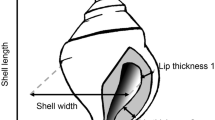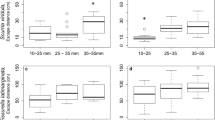Abstract
Interactions between the predatory sea star Pycnopodia helianthoides (Brandt, 1835) and two of its natural prey, the sea urchins Strongylocentrotus purpuratus (Stimpson, 1857) and S. franciscanus (Agassiz, 1863), are examined with regard to predator preference, predator diet, and prey defenses. The sea star is able to detect both species of sea urchin upstream in a Y-trough, but does not consistently choose one over the other (i.e., no preference). However, when the sea star is presented with equal numbers of similar-sized specimens of the two species of sea urchin, its diet is markedly nonrandom, since S. purpuratus is eaten almost 98% of the time. The defensive responses of the two species of sea urchin differ in form and effectiveness. S. franciscanus employs its long spines as defensive weapons, pinching the rays of an attacking sea star. This defensive response is more effective than the pedicellarial response used by S. purpuratus. The nonrandom diet of the predator seems to result primarily from prey defensive responses that differ in effectiveness, rather than from an intrinsic, behavioral preference of the predator at an earlier stage in the predator/prey interaction.
Similar content being viewed by others
Literature Cited
Ansell, A.D.: Defensive adaptations to predation in the Mollusca. Symp. Ser. mar. biol. Ass. India 3, 487–512 (1969)
Castilla, J.C.: Responses of Asterias rubens to bivalve prey in a Y-maze. Mar. Biol. 12, 222–228 (1972)
— and D.J. Crisp: Responses of Asterias rubens to olfactory stimuli. J. mar. biol. Ass. U.K. 50, 829–847 (1970)
Chesson, J.: Measuring preference in selective predation. Ecology 59, 211–215 (1978)
Dayton, P.K.: Experimental evaluation of ecological dominance in a rocky intertidal algal community. Ecol. Monogr. 45, 137–159 (1975)
—, R.J. Rosenthal, L.C. Mahen and T. Antezana: Population structure and foraging biology of the predaceous Chilean asteroid Meyenaster gelatinosus and the escape biology of its prey. Mar. Biol. 39, 361–370 (1977)
Feder, H.M.: Escape responses in marine invertebrates. Scient. Am. 227, 92–100 (1972)
— and A. Christensen: Aspects of asteroid biology. In: Physiology of Echinodermata, pp 87–127. Ed. by R. Boolootian. New York: John Wiley & Sons 1966
Grant, P.T. and A.M. Mackie: Chemoreception in marine organisms, 295 pp. New York: Academic Press 1974
Jensen, M.: The response of two sea-urchins to the sea-star Marthasterias glacialis (L.) and other stimuli. Ophelia 3, 209–219 (1966)
Kjerskog-Agersborg, H.P.: Bilateral tendencies and habits in the twenty-rayed starfish Pycnopodia helianthoides (Stimpson). Biol. Bull. mar. biol. Lab., Woods Hole 35, 232–254 (1918)
Landenberger, D.E.: Studies on selective feeding in the Pacific starfish Pisaster in southern California. Ecology 49, 1062–1075 (1968)
Mauzey, K.P., C. Birkeland and P.K. Dayton: Feeding behavior of asteroids and escape responses of their prey in the Puget Sound region. Ecology 49, 603–619 (1968)
Menge, B.A.: Foraging strategy of a starfish in relation to actual prey availability and environmental predictability. Ecol. Monogr. 42, 25–50 (1972)
Menge, J.L. and B.A. Menge: Role of resource allocation, aggression and spatial heterogeneity in coexistence of two competing intertidal starfish. Ecol. Monogr. 44, 189–209 (1974)
Murdoch, W.W.: Switching in general predators: experiments on predator specificity and stability of prey populations. Ecol. Monogr. 39, 335–354 (1969)
Paine, R.T.: The Pisaster-Tegula interaction: prey patches, predator food preference, and intertidal community structure. Ecology 50, 950–961 (1969)
Paul, A.J. and H.M. Feder: The food of the sea star Pycnopodia helianthoides (Brandt) in Prince William Sound, Alaska. Ophelia 14, 15–22 (1975)
Phillips, D.W.: The effect of a species-specific avoidance response to predatory starfish on the intertidal distribution of two gastropods. Oecologia (Berl.) 23, 83–94 (1976)
— Chemical mediation of invertebrate defensive behaviors and the ability to distinguish between foraging and inactive predators. Mar. Biol. 49, 237–243 (1978)
Ricketts, E.F., J. Calvin and J.W. Hedgpeth: Between Pacific tides, 614 pp. Stanford: Stanford University Press 1968
Rosenthal, R.J. and J.R. Chess: A predator-prey relationship between the leather star, Dermasterias imbricata, and the purple urchin, Strongylocentrotus purpuratus. Fish. Bull. U.S. 70, 205–216 (1972)
Tegner, M.J. and P.K. Dayton: Sea urchin recruitment patterns and implications of commercial fishing. Science, N.Y. 196, 324–326 (1977)
Van Veldhuizen H.D.: Feeding biology of subtidal Pisaster brevispinus on soft substrate in Bodega Harbor, California, 197 pp. Ph.D. thesis, University of California, Davis 1978
Wobber, D.R.: Agonism in asteroids. Biol. Bull. mar. biol. Lab., Woods Hole 148, 483–496 (1975)
Zafiriou, O.: Response of Asterias vulgaris to chemical stimuli. Mar. Biol. 17, 100–107 (1972)
—, K.J. Whittle and M. Blumer: Response of Asterias vulgaris to bivalves and bivalve tissue extracts. Mar. Biol. 13, 137–145 (1972)
Author information
Authors and Affiliations
Additional information
Communicated by N. D. Holland, La Jolla
Rights and permissions
About this article
Cite this article
Moitoza, D.J., Phillips, D.W. Prey defense, predator preference, and nonrandom diet: The interactions between Pycnopodia helianthoides and two species of sea urchins. Marine Biology 53, 299–304 (1979). https://doi.org/10.1007/BF00391611
Accepted:
Issue Date:
DOI: https://doi.org/10.1007/BF00391611




